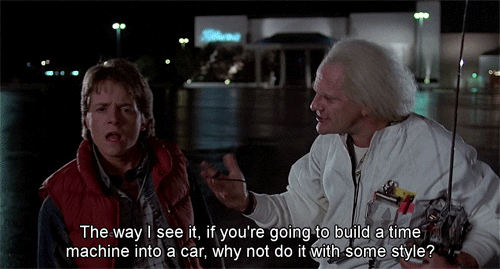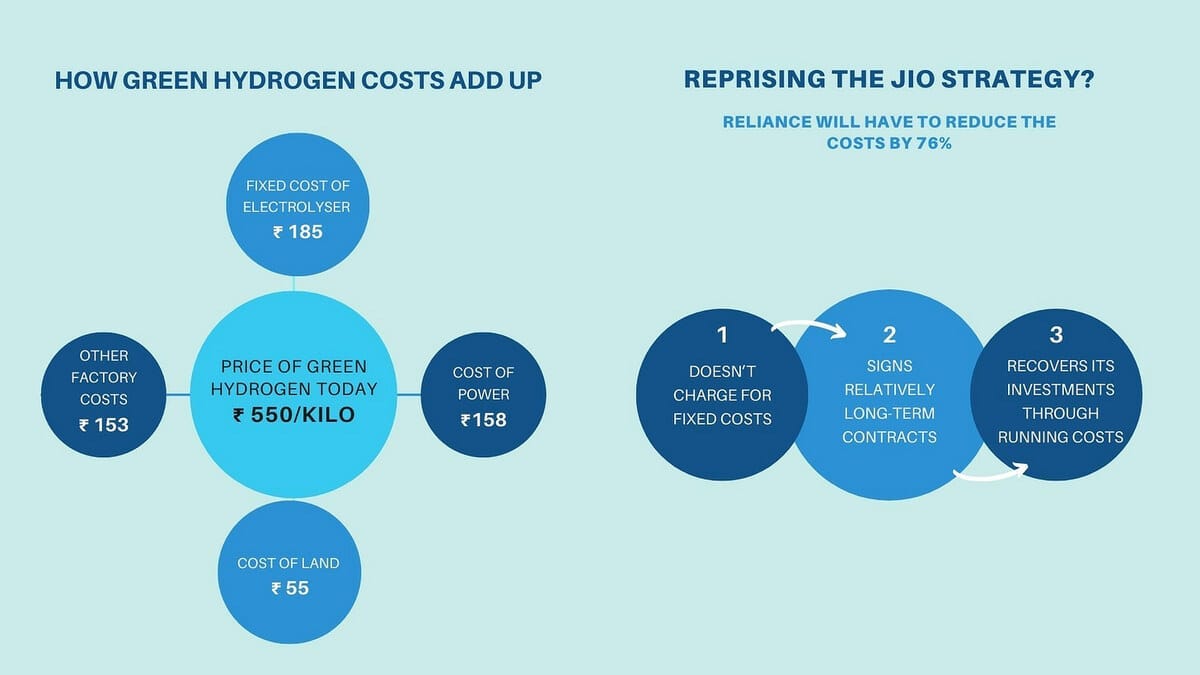Will Ambani's promise be like Tata's?
Reliance’s green hydrogen project’s success depends on scale and government support
Good Morning! A big hello to readers who signed up this week. This is The Signal’s weekend edition. Our story today by award-winning journalist M Rajshekhar is about Reliance Industries’ big promise to deliver green hydrogen at $1/kg. If achieved, it would dramatically alter the Indian economy. Also in today’s edition: the best reads from the week. Happy weekend reading.

A car for ₹1 lakh. That was the promise that Ratan Tata made. One family, one car, ₹1 lakh. 1-1-1.
In 2003, when Tata first declared the ambitious project, the excitement triggered was genuine. The cheapest car in India at the time, the Maruti 800, cost twice as much.
The announcement set off much speculation about the radical rethinking such a car entailed, design innovations it promised, and engineering feats in store. It wasn’t a quadricycle for sure, Tata Motors had clarified. Would it be an electric car? Anticipation mounted about other transformations the vehicle might bring. India’s car market might expand by as much as 65%, Crisil famously predicted.
We all know how that story turned out. When the Nano finally arrived in 2009 accompanied by Ratan Tata’s famous statement, ‘a promise is a promise’, the cheapest variants started at ₹1.3 lakh with taxes.
The reasons ran deep. Innovations and clever design pushed the price down to a degree but not enough to close in on the promise. Low cost of land (the acquisition helped by the government) and tax holidays — 25-year exemption from VAT — pushed the price down some more. The last mile in cost reduction was expected to be covered by economies of scale. That did not happen.
Instead of buying the cheapest car in the market, families decided to save a bit more, or pay EMIs for longer periods, and get the 800. Or buy a used 800. Instances of Nanos catching fire didn’t help.
In its best year, 2011-12, Tata Motors sold no more than 74,527 Nanos, well below the plant’s production capacity of 2.5 lakh cars a year. With scale not kicking in, prices stayed higher than expected.
In 2019, the company sold only one Nano. Exactly 10 years after the first car rolled out, the promise of 1-1-1 was quietly extinguished.
Reliance’s Hydrogen Play
Close to twenty years later, another billionaire tycoon has made a similarly transformational promise. In September this year, Reliance Industries chairman Mukesh Ambani announced his 1-1-1 vision. The group would, he said, bring the cost of green hydrogen below $1 per 1 kg in 1 decade.
It’s an audacious vow.
The world needs to decarbonise urgently but lacks all the pathways. Renewables cannot produce the heat that industries such as steel need. Long-haul vehicles need to be weaned off oil but batteries currently are too heavy and need frequent charging.
Green hydrogen could be the answer but at $6-7 a kg, it is too expensive. Hydrogen is mostly produced from natural gas or coal using a technology called Steam Methane Reforming, or SMR. Another method is electrolysis, which uses electricity to separate hydrogen and oxygen. Hydrogen produced by the second method of splitting water molecules with electricity from renewable sources is called green hydrogen. Bringing its cost down to $1 per kg would dramatically alter the running costs of vehicles and factories. This is why Mukesh Ambani’s promise is significant.
Can Reliance succeed where Tata failed?
There are three potentially lucrative businesses in the emerging hydrogen market—developing the tech; making cheap electrolysers; or producing cheap hydrogen. Reliance is making a play for the latter two.
Frugal engineering

The cost of green hydrogen is determined by the prices of the electrolyser, electricity to run it, water to feed it, and the cost of running and maintaining the plant.
Green hydrogen costs about ₹550 a kg today, according to an executive working on the hydrogen initiative of a large business group. “Of this, ₹158 is the cost of power; ₹185 is the cost of the electrolyser; EPC (the cost of setting up the whole factory) adds another ₹153, and the final ₹55 is incurred on land,” the executive, who did not wish to be named, told The Intersection.
To bring the price of the gas down to even ₹143 ($2) per kg, Reliance will have to score a 76% reduction in these costs. The biggest cost-head is the electrolyser. Reliance has signed a memorandum of understanding with Denmark’s Stiesdal Fuel Technologies. Stiesdal has designed a low-cost electrolyser — at about $231 per kW compared to the going price range of $550-1,100/kW. That means the upfront capital expenditure will come down by about 60%.
How did Stiesdal manage to cut the cost of the machine? By falling back on relatively old alkaline technology. Founder Henrik Stiesdal told ReCharge that the company was aiming to design an electrolyser that could be manufactured at scale. Unlike modern Proton Exchange Membrane electrolysers, alkaline electrolysers do not need rare metals such as iridium or platinum.
That removes one limiting factor for production and helps build scale. Tax breaks could bring down costs some more. It then boils down to other major cost-heads such as electricity. “It takes 50-55 units of power to produce one kg of hydrogen. Multiply that by ₹2 (solar tariffs today) and that is ₹100-110,” said the Mumbai-based executive.
This is where Reliance faces tough choices. If it produces hydrogen close to the renewables plant, it has to invest in expensive transportation infrastructure for the gas. Hydrogen is quick to catch fire, and so it needs to be cooled to -252°C before transportation. Alternatives such as storing it as ammonia are more stable but involve expensive re-conversion. If it sets up electrolysers closer to consumption centres, transmission charges will push up the cost of electricity.
Add to it the costs of land and capital. Reliance could be expected to bargain a good deal from both union and state governments for land. A PLI scheme for hydrogen that is expected next year could bring down the cost of capital.
Achieving scale is less predictable. That is where the Nano skidded. And this is where the government comes in.
Expanding the market
At this time, no more than a handful of industries such as petrochemicals and fertilisers use hydrogen. Production capacities have stayed low because of their limited demand.
The Indian government is determined to create a bigger market for green hydrogen. “I announce National Hydrogen Mission,” Prime Minister Narendra Modi declared this Independence Day.
The government is planning to mandate refiners and fertiliser plants to use green hydrogen, beginning at 10% in 2023-24 and rising to 25% of their overall requirement in five years. It is also pushing automakers to switch to electric and hydrogen fuel-powered vehicles.
Reliance is aiming for scale in different ways. Alkaline electrolysers do not need high temperatures to operate. This means it can be bought by a wider set of customers — not just steel mills — expanding the size of the potential market.
There are other elements to Reliance’s strategy, though. According to a senior bureaucrat in the union government who has held discussions with company executives, the group wants to reprise its telecom strategy in renewable power. Reliance Jio had given phones away for free but charged for airtime.
In energy too, said the bureaucrat, the group might set up for free renewable energy infrastructure in residential clusters and industrial areas — think small local grids comprising solar/wind installations and electrolysers that deliver 24x7 power — and charge only for the power. “Given their scale, they could offer a rate of about ₹3/kwh,” he said.
This would be a disruptive idea, weaning entire settlements (in India and elsewhere) off discoms and establishing Reliance as a micro-grid manager and power supplier. Such a model can also deliver extraordinary scale.
ICYMI

GE Split: The split of conglomerate General Electric into three public companies marks the end of an era in US corporate history. This piece examines the reasons behind the decision and how eventually having smaller units is better.
Concert Tragedy: The stampede at rapper Travis Scott's Astroworld concert came as a shocker to music lovers. This first-person account says that despite people passing out, other fans continued to 'party' and even obstructed ambulances leading to delays in offering medical assistance. Scott has now asked victims' families to reach out to him for help.
Ageless Bollywood: It is never too late to pursue one's dreams, especially if it involves acting. A story in The New York chronicles the journey of Richard Klein from life as a California-based Hebrew teacher to becoming a Bollywood actor in Mumbai.
Fishy Affair: Have you ever wondered how Sushi came to America? An interactive NYT story gives a glimpse of Sun Myung Moon’s sushi revolution, his patron Takeshi Yashiro who later oversaw operations, and how this group dominates the seafood industry in the US.
Hard Twitch: How difficult can streaming be? Pretty tough, say live-streamers on Twitch. Battling weight gain, back pain, and rising stress, these streamers are now feeling the heat of being online for hours. Some of them are even contemplating whether this is worth the low payout.
Covid Coverup: For months, Tanzania denied the existence of Coronavirus. As the death toll mounted and secret burials began, reality emerged. An investigative piece by The Wall Street Journal digs deeper into the biggest Covid coverup anywhere in the world. Tanzania’s President John Magufuli also died in March amidst Covid rumours, an allegation that the country has vehemently denied.



